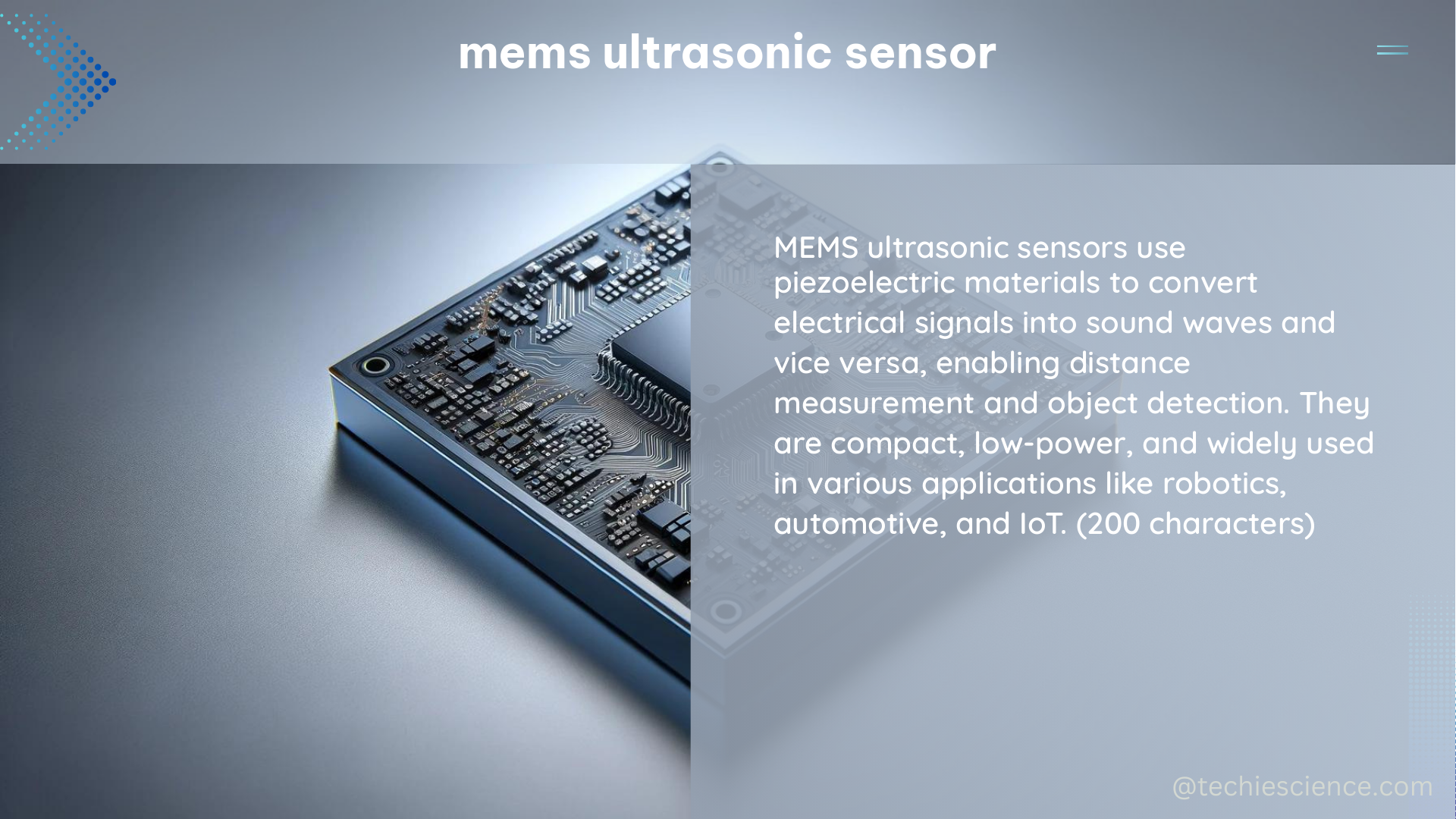MEMS (Micro-Electro-Mechanical Systems) ultrasonic sensors are compact, high-performance devices that can convert electrical energy into mechanical energy and vice versa. These sensors have a wide range of applications, including distance measurement, sonar, medical imaging, ultrasonic therapy, non-destructive testing, and flow monitoring. In this comprehensive guide, we will delve into the technical details and capabilities of MEMS ultrasonic sensors, providing you with a thorough understanding of this cutting-edge technology.
Resonant Frequency and Acoustic Pressure Distribution
The MEMS ultrasonic transducer developed in a recent study has a resonant frequency of 960 kHz, which is consistent with the design specifications. The acoustic pressure distribution of the transducer array shows that in the far-field range, as the distance increases, the sound pressure decreases. At a distance of 1.8 cm from the focus point position, the sound pressure is half of that at the focus point position, which can meet the monitoring requirements for eye-blinking applications.
| Parameter | Value |
|---|---|
| Resonant Frequency | 960 kHz |
| Sound Pressure at 1.8 cm from Focus Point | 50% of Focus Point |
The lateral acoustic pressure directivity of the MEMS ultrasonic transducer array has a -6 dB sound beam bandwidth of 1.7 mm, indicating excellent acoustic pressure directivity. This narrow beam width allows for precise targeting and monitoring of specific areas, such as the eye region for blinking detection.
Furthermore, the acoustic pressure of the MEMS ultrasonic transducer array at different drive frequencies has a -6 dB bandwidth ranging from 938 kHz to 1020 kHz. This wide operational bandwidth provides flexibility in tuning the sensor to specific applications and environments.
Advantages of MEMS Ultrasonic Sensors

MEMS ultrasonic sensors offer several advantages that make them highly versatile and widely adopted in various measurement fields:
- High Sensitivity: MEMS ultrasonic transducers exhibit high sensitivity, enabling them to detect and respond to even subtle changes in the environment.
- Wide Beam Angle: The wide beam angle of MEMS ultrasonic sensors allows for broader coverage and monitoring of larger areas, making them suitable for applications such as proximity detection and gesture recognition.
- Low-cost Mass Production: MEMS technology enables the cost-effective mass production of these sensors, making them accessible for a wide range of applications.
- Miniaturization: The compact size of MEMS ultrasonic sensors allows for their integration into various devices and systems, enabling the development of innovative and space-efficient solutions.
Applications of MEMS Ultrasonic Sensors
MEMS ultrasonic sensors are employed in a diverse range of applications, leveraging their unique capabilities:
- Distance Measurement: MEMS ultrasonic sensors are widely used for accurate distance measurement, enabling applications such as proximity detection, object tracking, and level sensing.
- Sonar: MEMS ultrasonic sensors play a crucial role in sonar systems, providing the necessary transducer technology for underwater navigation, object detection, and mapping.
- Medical Imaging: In the medical field, MEMS ultrasonic sensors are used in imaging techniques, such as echocardiography and diagnostic ultrasound, to generate high-resolution images of internal structures.
- Ultrasonic Therapy: MEMS ultrasonic sensors are employed in therapeutic applications, where they generate focused ultrasound waves for the treatment of various medical conditions, such as cancer and chronic pain.
- Non-Destructive Testing: MEMS ultrasonic sensors are utilized in non-destructive testing (NDT) methods, enabling the inspection and evaluation of materials and structures without causing any damage.
- Flow Monitoring: MEMS ultrasonic sensors are used in flow monitoring applications, such as water and gas metering, to measure the volumetric flow rate of fluids.
Overcoming Challenges with MEMS Ultrasonic Sensors
MEMS ultrasonic sensors offer several advantages over traditional tracking systems, such as visual tracking, IMU-based systems, and stretch-based systems. These sensors can overcome the challenges associated with these alternative approaches:
- Visual Tracking Limitations: MEMS ultrasonic sensors are not affected by ambient light conditions, making them suitable for use in environments with varying lighting conditions, where visual tracking systems may struggle.
- IMU-based System Drawbacks: Unlike IMU-based systems, MEMS ultrasonic sensors are not susceptible to drift and can provide more accurate and reliable tracking data over time.
- Stretch-based System Constraints: MEMS ultrasonic sensors do not rely on the stretching or deformation of materials, which can introduce errors and limitations in stretch-based tracking systems.
By leveraging the unique capabilities of MEMS ultrasonic sensors, researchers have developed innovative solutions, such as a glove that integrates multiple MEMS-ultrasonic sensors to obtain a pairwise distance matrix for each hand pose. This approach overcomes the challenges of other tracking systems and enables the creation of highly accurate and cost-effective hand-tracking solutions.
Conclusion
MEMS ultrasonic sensors are a remarkable technology that combines high sensitivity, wide beam angle, and cost-effective mass production. These sensors have a wide range of applications, from distance measurement and sonar to medical imaging and non-destructive testing. By overcoming the limitations of traditional tracking systems, MEMS ultrasonic sensors are enabling the development of innovative solutions in various industries. This comprehensive guide has provided you with a deep understanding of the technical details and capabilities of MEMS ultrasonic sensors, equipping you with the knowledge to explore and leverage this cutting-edge technology.
Reference:
- MEMS Ultrasonic Transducer Array for Eye-Blinking Monitoring
- Ultrasonic Transducers: Materials and Design for Sensors, Actuators and Medical Applications
- HandSense: A Glove-Based Hand Tracking System Using MEMS Ultrasonic Sensors

The lambdageeks.com Core SME Team is a group of experienced subject matter experts from diverse scientific and technical fields including Physics, Chemistry, Technology,Electronics & Electrical Engineering, Automotive, Mechanical Engineering. Our team collaborates to create high-quality, well-researched articles on a wide range of science and technology topics for the lambdageeks.com website.
All Our Senior SME are having more than 7 Years of experience in the respective fields . They are either Working Industry Professionals or assocaited With different Universities. Refer Our Authors Page to get to know About our Core SMEs.